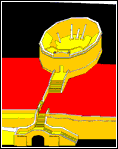
A Story of Cultural Clash
Perth, Western Australia
 Round House 1831
Round House 1831
The first public building built by the British in W.A.
The series of paintings A LAND PROJECTED - Maps and Mythologies, 1990 by Phillip Gibbs is based on research into the nature of European occupation and settlement of Western Australia. The cultural characteristic shared by Aboriginal peoples and the British was the dependence of both societies on mapping the land. Aboriginal artists made map/paintings as part of the explanation of the origin of the land and in order to harmonize with it. The British mapped the land to assist with its exploitation and as the basis of settlement.
The total dependence of Aboriginal culture on the land and the total dislocation of Aboriginal communities from the land is now apparent to the non-aboriginal community.
In Aboriginal mythology a fabulous creature, the Wagyl or winged serpent, is said to inhabit the reaches of the Swan River. The Wagyl is attributed with the formation of the bed of the river as it slid through the sand with its hugh body. The river bed is the track left behiend by the Wagyl and is evidence of its existence.The swan, another winged creature and the subject of many European fables, was adopted by British settlers as the emblem of the West. When the British troops travelled up the Swan River they were amazed by the numbers and magnificence of the Black Swan, a species unique to this region. To the local Aboriginals, the Nyungah people, the attendance of the Black Swan as a minature manifistation was additional evidence of the veracity of their story.
The map of Perth and Perth Water configures to synthesize these two great mythologies.
 Perth - The Winged Creature,
Perth - The Winged Creature,1990 (oil on canvas, 6'0"x6'0")
"History has a profound influence on the shape and character of all cities." Gordon Stephenson, The Design of Cities, UWA Press 1975. The character of Perth's plan configuration has evolved from sculpturing the Swan River; from the northern form shaped by the roads that were once the tracks of early settlers who adopted the ancient Aboriginal parthways; the Townsite Plan of 1833 and rural allotments; the Mitchell Freeway located on the edge of the wetlands following the natural boundary and the old Aboriginal tracks; and the ovoids of the Narrows Interchange located on reclaimed swamp land.
 A Western Entreaty,
A Western Entreaty, 1990 (oil on canvas,6'0"x6'0")
In 1987 Harold Thomas of the Luritja tribe made the drawing which was universally adopted by the Aboriginal peoples as their flag. The acknowledgement of Aboriginal societies as the originating culture of the land would lead to the incorporation of this design into the Australian ensign and the flag of the State of Western Australia.
Uluru (Ayers Rock) was handed back to the original owners in 1985 and has become a symbol of achievement for the land rights movement.
"Aboriginal people have been responsible for working cattle, sheep, horses and men right through the Kimberly."
Corringe Community New Aboriginal housing combines hi-tech domed structures with traditional artwork.
 The Black Stockman,
The Black Stockman,1990 (oil on canvas, 6'0"x6'0")
"We've been good workers too. We know the country. We know the environment. We understand its character and its history. We are the people of this country. We should be given an equal say in any development proposals and we should be given a more equal say in the running of stations." John Watson, Raparapa - Stories from the Fitzroy River drovers Magabala Books 1988.
Jane Currie painted the Panoramic View of the Swan River Settlement in 1830-32. She shows the Round House, the first building built by the British, perched on an outcrop of limestone rock. The building was used to contain chain gangs of Aboriginal men. In 1833 J.S.Roe made the initial survey laying out the town of Fremantle. He placed High Street and Market Street in the form of a cross with the Church in Kings Square at the top end of High Street and the Round House at the other. This configuration was referred to as 'heaven and hell'.
 Wreath at
Wreath at the Foot of the Cross,
1990 (oil on canvass, 6'0"x6'0")
The tunnel under the Round House was cut through the rock in 1837 by Boston whalers in return for the use of Aboriginal women in the processing of whale oil. The Fremantle Prison was built in 1855 on an axis facing the Round House. The line of sight from the Round House to the prison clock facilitated the transfer of men from one lock-up to the other.
Rottnest Island was used as a 'native prison' and forced labour camp for Aboriginal men from 1838 until 1903. The Rottnest octagonal compound was a larger enclosure than the Round House but based on similar design principles. A high perimeter limestone wall encircled the compound with stone cells lining the inside of the wall. The system was said to have its origins in Russia as a device to house surfs in labour camps.
 Rottnest from
Rottnest from the Round House,
1990 (oil on canvass, 6'0"x6'0")
In the early 1960's, Public Works Department Sewerage excavations on Rottnest Island unearthed human remains along the lines of their construction. The extent of this 'native cemetery' unmarked grave-site was subsequently estimated to encompass a circle of 100m diameter. The Rottnest Island Death's Group of Aboriginal Elders was formed to protect the site and tell the story.